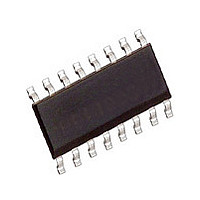HCPL-788J Avago Technologies US Inc., HCPL-788J Datasheet - Page 16

HCPL-788J
Manufacturer Part Number
HCPL-788J
Description
OPTOCOUPLR AMP CURR SENSE 16SOIC
Manufacturer
Avago Technologies US Inc.
Series
-r
Type
Current Sensorr
Specifications of HCPL-788J
Package Type
SOIC
Operating Supply Voltage (typ)
5V
Voltage - Isolation
3750Vrms
Input Type
DC
Voltage - Supply
4.5 V ~ 5.5 V
Operating Temperature
-40°C ~ 85°C
Mounting Type
Surface Mount
Package / Case
16-SOIC (0.295", 7.50mm Width)
No. Of Amplifiers
1
Input Offset Voltage
3mV
Bandwidth
30kHz
Isolation Voltage
3.75kV
Supply Voltage Range
± 4.5V To ± 5.5V
Supply Current
20mA
Amplifier Case Style
SOIC
No. Of Pins
16
Rohs Compliant
No
Lead Free Status / RoHS Status
Not Compliant
Available stocks
Company
Part Number
Manufacturer
Quantity
Price
Company:
Part Number:
HCPL-788J
Manufacturer:
AVAGO
Quantity:
6 800
Part Number:
HCPL-788J
Manufacturer:
AVAGO/安华高
Quantity:
20 000
Company:
Part Number:
HCPL-788J#300E
Manufacturer:
AVAGO
Quantity:
15 000
Company:
Part Number:
HCPL-788J#500
Manufacturer:
AVAGO
Quantity:
25 000
Company:
Part Number:
HCPL-788J#500E
Manufacturer:
AVAGO
Quantity:
7 000
Company:
Part Number:
HCPL-788J-000E
Manufacturer:
AVAG0
Quantity:
12 000
Part Number:
HCPL-788J-500E
Manufacturer:
AVAGO/安华高
Quantity:
20 000
Figure 28. Motor output horsepower vs. motor
phase current and supply voltage.
Current Sensing Resistors
The current sensing resistor should have low resistance
(to minimize power dissipation), low inductance (to min-
imize di/dt induced voltage spikes which could adversely
affect operation), and reasonable tolerance (to main tain
overall circuit accuracy). Choosing a particular value for
the resistor is usually a compro mise between minimiz-
ing power dissipation and maximizing ac curacy. Smaller
sense resistance decreases power dissipation, while larg-
er sense resistance can improve circuit accuracy by utiliz-
ing the full input range of the HCPL-788J.
The first step in selecting a sense resistor is determin-
ing how much current the resistor will be sens ing. The
graph in Figure 28 shows the rms current in each phase
of a three-phase induction motor as a function of aver-
age motor output power (in horse power, hp) and motor
drive supply voltage. The maximum value of the sense
resistor is determined by the current being measured
and the maximum recommended input voltage of the
isolation amplifier. The maxi mum sense resistance can
be calculated by taking the maxi mum recommended
input voltage and dividing by the peak current that the
sense resistor should see during normal operation. For
example, if a motor will have a maximum rms current
of 10 A and can experience up to 50% overloads during
normal operation, then the peak current is 21.1 A
x 1.414 x 1.5). Assuming a maximum input voltage of 200
mV, the maximum value of sense resistance in this case
would be about 10 mΩ.
The maximum average power dissipation in the sense
resistor can also be easily calculated by multiplying the
sense resistance times the square of the maximum rms
current, which is about 1 W in the previous example.
16
40
35
30
25
20
15
10
5
0
0
MOTOR PHASE CURRENT – A (rms)
5
440
380
220
120
10
15
20
25
30
35
(=10
If the power dissipation in the sense resistor is too
high, the resistance can be decreased below the
maximum value to decrease power dissipation.
The minimum value of the sense resistor is limited by
precision and accuracy requirements of the design. As
the resistance value is reduced, the output voltage across
the resistor is also reduced, which means that the offset
and noise, which are fixed, become a larger percentage
of the signal amplitude. The selected value of the sense
resistor will fall somewhere between the minimum and
maximum values, depending on the particular require-
ments of a specific design.
When sensing currents large enough to cause significant
heating of the sense resistor, the temperature coefficient
(tempco) of the resistor can introduce nonlinearity due
to the signal dependent temperature rise of the resistor.
The effect increases as the resistor-to-ambient thermal
resistance increases. This effect can be minimized by
reducing the thermal resistance of the current sens-
ing resistor or by using a resistor with a lower tempco.
Lowering the thermal resistance can be accomplished
by reposi tion ing the current sensing resistor on the PC
board, by using larger PC board traces to carry away
more heat, or by using a heat sink.
For a two-terminal current sensing resistor, as the value of
resistance decreases, the resistance of the leads become
a significant per centage of the total resistance. This has
two primary effects on resistor accuracy. First, the effec-
tive resistance of the sense resistor can become depen-
dent on factors such as how long the leads are, how they
are bent, how far they are inserted into the board, and
how far solder wicks up the leads during assembly (these
issues will be discussed in more detail shortly). Second,
the leads are typically made from a material, such as cop-
per, which has a much higher tempco than the material
from which the resis tive element itself is made, result ing
in a higher tempco overall.
Both of these effects are eliminated when a four-terminal
current sensing resistor is used. A four-terminal resistor
has two additional terminals that are Kelvin-connected
directly across the resistive element itself; these two ter-
minals are used to monitor the voltage across the resis-
tive element while the other two terminals are used to
carry the load current. Because of the Kelvin connection,
any voltage drops across the leads carrying the load cur-
rent should have no impact on the measured voltage.
















